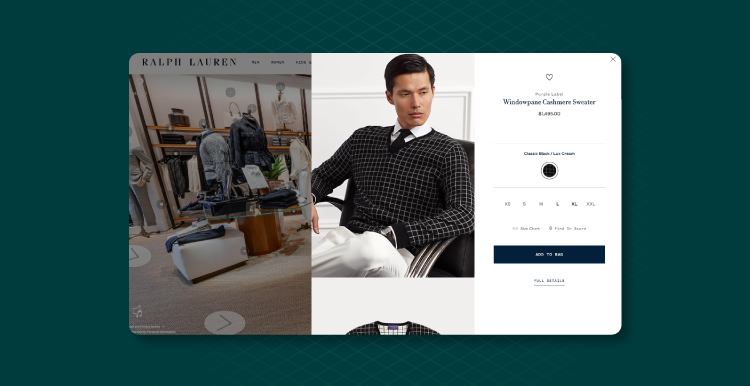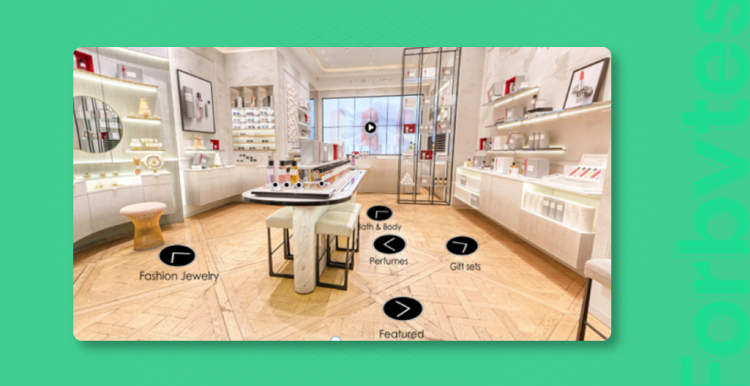With the pace of digital transformation, consumer expectations are changing faster than ever. E-commerce keeps growing, and the market is filling up with tech-driven solutions that make competition even tougher. To keep up, virtual retail brands need new ways to connect with shoppers—ways that feel more immersive, convenient, and accessible than a physical store.
That’s why many businesses are rethinking their strategies and exploring virtual stores as a fresh way to deliver richer, more engaging online shopping experiences. It’s not just about selling products anymore; it’s about creating a space where customers can interact, discover, and shop in a way that feels both intuitive and exciting.
E-commerce is an integral part of the retail business where brands are looking for a way to close the gap and deliver a more authentic and personalized experience to their users, just like they are in-store. That’s how the new era has started, powered by artificial intelligence, virtual and augmented reality, live stream shopping platforms, 3D modeling, and other tangent technologies that contributed to the emergence of 3D virtual stores.
Therefore, to keep pace with customers’ expectations and to stay competitive, business owners need to evolve virtual selling. In this article, we are going to unleash the benefits, use cases, and innovative examples of virtual stores in the retail industry.
What Is a Virtual Store?
A virtual store is the eCommerce environment transformed from physical stores toward the adoption of connected technologies to bridge the gap between in-store and digital experiences. Virtual stores are fueled by virtual reality and augmented reality technologies. Whether it is a 3D virtual retail space or a mobile augmented reality application, you get a personalized and interactive experience while selecting furniture items for your kitchen or an exquisite dress for your dancing party.
The move to digital shopping got a big boost from VR/AR, and now a virtual store can do things a regular website can’t. Shoppers can connect with brands in real time, try on items without leaving their couch, get instant answers, and enjoy smart recommendations as they browse. It’s a shopping experience that feels easier, faster, and way more engaging.
Virtual stores are changing the way customers interact with brands by blending the best of physical and digital shopping. In these virtual stores, shoppers can explore products in 3D virtual reality, receive tailored recommendations, and enjoy immersive experiences that feel almost like being in a real store. By making online shopping experience interactive and personalized, virtual stores help increase engagement, reduce returns, and create a stronger connection between customers and your brand.
Why Your Business Needs Virtual Stores
Considering the preferences and needs of current solvent tech-savvy generations, Millennials and Gen Z, companies have to cater to them and ensure immediacy and real-time interactivity. According to one survey, 70% of online shoppers who have visited virtual stores made at least one purchase. A connected 3D virtual world of the metaverse for Millenials and Gen Z is a bridge to their sophisticated perceptions and demands which means brands have to leave the doors wide open to the connected world. According to McKinsey, the metaverse market is anticipated to generate up to $5 trillion by 2030.
Let’s take a look at how virtual reality stores can bring value to your virtual retail business.
- Increase in conversion rate
According to Shopify, compared to products without augmented reality, the implementation of AR/3D modeling into the product makes the conversion rate of product interactions 94 percent higher. As Shopify’s statistics show, the conversion rate of product pages has increased by up to 250%. Applying 3D models is more cost-efficient than opposed to traditional photos. For example, Rebecca Minkoff, a designer clothing and accessories brand, empowered their customers’ interactions with 3D virtual modeling, which resulted in 65% more likeliness of buying a product. All of this shows just how strongly 3D virtual experiences can improve engagement and drive results in virtual stores.
- Conversion of online customers to in-store consumers
Virtual stores are beneficial for retailers who seek new opportunities to reinvent their strategies to achieve instant customer flow to their online and in-store commerce. Being a catalyst for conversions, virtual shopping is capable of saving the future of physical stores by converting online users to in-store foot traffic. In other words, 3D virtual stores can bridge the gap between digital engagement and real-world shopping, giving brands a powerful way to grow their customer flow.
- Elimination of returns
The widespread headache of retailers is the number of returns that could reach a trillion dollars per year. While in-store purchases are returned 5-10%, online purchases returns reach 40 percent. To overcome this issue, VR in retail can assist customers in making more informed decisions following the virtual assessment of the product. Nike was one of the pioneers coming up with the AR initiative, Nike Fit, to struggle with high shipping and return costs. As a result, the mobile app helps customers choose accurate sizing by virtually measuring a foot. The mobile app lets customers find the right size by virtually measuring their foot — a great example of how virtual stores can reduce returns and improve overall shopping accuracy.
- Customer engagement improvement
According to a NielsenIQ study, 51% of consumers prefer to assess their products before purchasing by using AR. Having the possibility to flexibly visualize the product before the purchase, customers get more insights and the certainty of the product correspondingly. Moreover, in the modern realms, being involved in the immersive world, customers are collaborating with remote friends and exploring new feelings in the 3D virtual world. All of this makes AR-powered shopping a natural next step, and it’s one of the key reasons retailers are increasingly turning to virtual stores.
- Sales increase
Providing the customer with confidence in the product and ensuring a novel approach toward their engagement, virtually powered apps can drive increased sales and ROI. The previous benefit of reducing returns impacts the bottom line of business performance since a returning customer is a happy one. Building loyalty is one of the prioritized aims of any business, particularly being propelled by digital initiatives. Once you cram your customers with tailored solutions they engage with in real-time at their convenience, the likelihood of sales increases. Additionally, by applying personalized virtual consultancy, your marketing strategy can be enhanced with cross-selling and up-selling opportunities. In short, integrating these immersive experiences into your virtual store makes your entire customer journey stronger and more profitable.
- Personalized experiences
Virtual stores enable retailers to analyze clients’ shopping behavior patterns and by streamlining marketing research, deliver remarkable personalized experiences, and allow foe earning customer loyalty. Plunging into the digital realm, users are focused on their persona: expression. This mainly relates to the fashion industry where customers’ needs are customized in a way they would not be able to repeat in-store. 3D virtual experience cannot be duplicated when walking into Gucci’s physical mall center and waiting for feedback from the sales representative. Virtual shopping accelerates intentions to buy the product by saturating the whole customer’s self-estimation and self-expression in the virtual world. And that’s exactly why virtual stores are quickly becoming a must-have for brands that want to elevate engagement and accelerate purchase decisions.
Ultimately, virtual stores are not just a tech trend, they’re a strategic opportunity for any retailer looking to connect with customers in new, meaningful ways. By offering immersive, interactive, and personalized online shopping experiences, virtual stores help brands increase engagement, drive conversions, and build loyalty. Embracing virtual stores today means preparing your business for the future of retail, where digital and physical experiences merge seamlessly.
Virtual Store Use Cases That Drive Sales
1. Virtual Try-on
Since Millennials and Gen Z spend a lot of time in spaces that offer interactive and personalized experiences, brands and retailers need to show up where their customers already are inside virtual stores. These environments let shoppers explore products, interact with brands, and make decisions in a way that feels natural and fun.
Backed by 3D body scanning, AR is reinventing the retail virtual experience across fashion, cosmetics, and luxury. How does it work? With a camera-equipped device and 3D virtual fitting technology, shoppers get a realistic view of how an outfit, shade, or accessory will look on them. No lines, no guesswork. Virtual stores with try-on features let customers experiment with garments, makeup, and luxury items for size, fit, and style, all before buying. Gucci, for example, already lets customers try on sneakers directly in their app.
There is also the option to create your own avatar and try on virtual clothing as you like. 3D LOOK’s Your Fit solution lets buyers represent their exact measurements, offering accurate size recommendations and interactive online shopping journeys tailored to unique body shapes—perfect for enhancing virtual stores experiences.
Collaborating with Google Search, Burberry launched an AR-powered initiative to give customers a realistic sense of products, further improving engagement in virtual stores.
L’Oréal partnered with Snap Camera to bring its branded content to life. Through AR lenses on Snap’s desktop app, customers can try on different looks from Garnier, Lancôme, L’Oréal Paris, and Maybelline. Similarly, Kohl implemented the AR Virtual Closet with Snapchat, allowing shoppers to browse selections and create trendy outfits from home. Brands like Sephora, Kendra Scott, IKEA, Home Depot, Louis Vuitton, and Levi’s are also using virtual stores to deliver interactive and personalized shopping experiences.
2. 3D Webstores
The possibility to virtually browse virtual stores allows retailers to merge the in-store experience with eCommerce features. This means you appear on an unconventional website equipped with virtual-powered capabilities, including interactive access to physical stores through 3D rendering.
Visual elements like 3D models, 360-degree views, and technology similar to Google Street View give shoppers an immersive experience of walking around the store. For example, Ralph Lauren’s 3D webstore lets users explore the store virtually by clicking arrows and icons that provide detailed product information leading to the cart. Similarly, major fashion brands like Tommy Hilfiger, Burberry, and Gucci have embraced virtual stores to offer this engaging online experience.
With virtual stores, customers get a doubled experience of gratification since virtual exploring of the store allows them to save time and hassle as well as digitally transform to in-real-life shopping, as in the example of Christian Dior offering the chance to visit its Champs-Elysées boutique.
With virtual stores, customers enjoy a double dose of convenience and excitement. Exploring products in virtual stores saves time and effort while giving a rich, immersive experience that mirrors real-life online shopping like Christian Dior’s Champs-Élysées boutique, which shoppers can visit virtually from anywhere.
3. Gamification for customer satisfaction
As we mentioned before, gaming is not the only use case for applying digital products. However, it is a great way to be integrated into virtual stores and form a holistic strategy of customer engagement. One of the notorious examples is Nike, which in collaboration with Roblox rolled out Nikeland to deliver a new-level shopping experience to its consumers. In the Nikeland Showroom, users can deck out their avatars from a collection of shoes and clothes and play sports in the virtual game.
For its bicentennial, the Louis Vuitton brand launched a video game with collectible NFT postcards, which gained 200 million downloads.
Final Thoughts
Digitalization is gaining momentum in the retail industry, offering such solutions as virtual stores, AR, and gamified experiences in the metaverse. Though customers (according to research) are excited about how brands are stepping into a digital experience, the total adoption of virtual retail is terminated due to technical challenges and a lack of talent to meet the demand for growth. There are a lot of myths indicating that VR ecommerce is a fad. Modern marketplaces have been changing with the shifting demands of the customers whose lifestyle dictates how to consume content and how to engage with products. Therefore, businesses must adapt to new realms and keep a pulse on technological advancements, which open up new avenues for customer engagement and building loyalty.
Immersive content backed by virtual realities increases customer satisfaction, drives sales, helps build a powerful community base, and ensures sales revenue increase via an omnichannel approach. Moreover, with VR in e-commerce, you can conduct various research marketing activities. So that retailers can easily try out different ways of design, item location, and product layout for their virtual stores to boost conversion in real life.
Based on the aforementioned use cases, we understand that both consumers and retailers are likely to embrace 3D virtual store technologies, even if they are immature for the present. Now that you know how augmented and virtual realities are changing eCommerce and the way people shop, we invite you to talk with our specialists about your eCommerce website development accelerated with virtual technologies.

Our Engineers
Can Help
Are you ready to discover all benefits of running a business in the digital era?

Our Engineers
Can Help
Are you ready to discover all benefits of running a business in the digital era?











